Network theory miscellaneous
- Which one of the following is the transmission matrix for the network shown in the figure given above?

1 1+yz 
y z 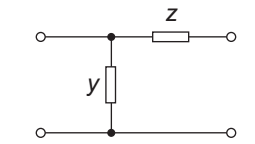
-
View Hint View Answer Discuss in Forum
The given figure:

The transmission matrix is given by:
V1 
= 
V2 

A B 
l1 -l2 C D
V1 = AV2 – BI2 . . . …(i)
and I1 = CV2 – DI2 . . .…(ii)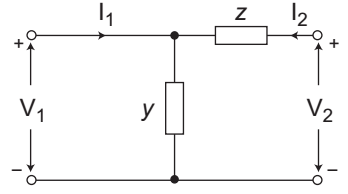
From figure:
V1 = (I1 + I2) × 1/y
andV2 = I2z + 
I1 + I2 
= l2z + I1 + I2 y y y
or
I1 = – I2 (1 + yz) + V2y . . . . .…(iii)
and V1 = – I2z + V2 …. . . . .(iv)
On comparing equation (i) and (ii) with (iii) and (iv), we get:
A B 
= 
1 z 
C D y 1+yz
Hence alternative (C) is the correct choice.Correct Option: C
The given figure:

The transmission matrix is given by:
V1 
= 
V2 

A B 
l1 -l2 C D
V1 = AV2 – BI2 . . . …(i)
and I1 = CV2 – DI2 . . .…(ii)
From figure:
V1 = (I1 + I2) × 1/y
andV2 = I2z + 
I1 + I2 
= l2z + I1 + I2 y y y
or
I1 = – I2 (1 + yz) + V2y . . . . .…(iii)
and V1 = – I2z + V2 …. . . . .(iv)
On comparing equation (i) and (ii) with (iii) and (iv), we get:
A B 
= 
1 z 
C D y 1+yz
Hence alternative (C) is the correct choice.
- What is the value of the parameter h12 for the 2-port network shown in the figure given above?

-
View Hint View Answer Discuss in Forum
The given network
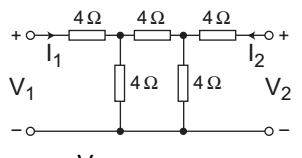
We know thath12 = V1 /I1 = 0 V2
The given network can be modified as: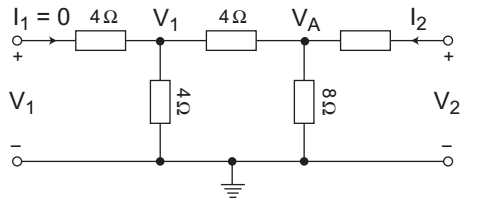
Applying KCL at node AVA- V2 + VA + VA- V1 = 0 4 8 4
orVA 
1 + 1 + 1 
= V2 + V1 4 8 4 4 4
or5 VA = V2 + V1 8 4 4
or5 VA = V2 + V1 …. . . . . . (i) 2
Again by applying potential divider ruleV1 = V1 × 4 = VA 2 2
or
VA = 2V1
Now5 .2V1 = V2 + V1 2
or
4 V1 = V2
orV1 = 1 = h12 = 0·250Ω V2 4
Hence alternative (C) is the correct choice.Correct Option: C
The given network

We know thath12 = V1 /I1 = 0 V2
The given network can be modified as:
Applying KCL at node AVA- V2 + VA + VA- V1 = 0 4 8 4
orVA 
1 + 1 + 1 
= V2 + V1 4 8 4 4 4
or5 VA = V2 + V1 8 4 4
or5 VA = V2 + V1 …. . . . . . (i) 2
Again by applying potential divider ruleV1 = V1 × 4 = VA 2 2
or
VA = 2V1
Now5 .2V1 = V2 + V1 2
or
4 V1 = V2
orV1 = 1 = h12 = 0·250Ω V2 4
Hence alternative (C) is the correct choice.
- What is the value of R required for maximum power transfer in the network shown above?
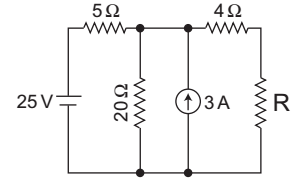
-
View Hint View Answer Discuss in Forum
The given network:
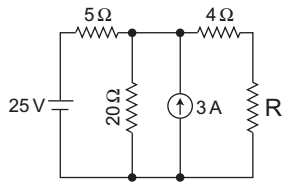
Let R = RL.
The value of R required for maximum power transfer in network is equivalent to net resistance as seen from the open load terminal (i.e. Thevenin’s resistance, Rth)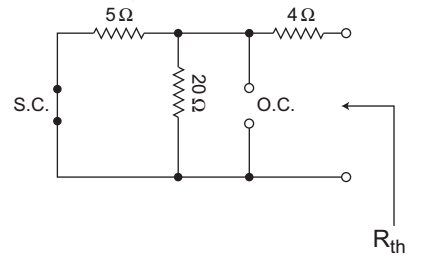
From above figure,
Rth = [5 || 20] + 4Ω = 4Ω + 4Ω = 8Ω
Hence alternative (C) is the correct choiceCorrect Option: C
The given network:

Let R = RL.
The value of R required for maximum power transfer in network is equivalent to net resistance as seen from the open load terminal (i.e. Thevenin’s resistance, Rth)
From above figure,
Rth = [5 || 20] + 4Ω = 4Ω + 4Ω = 8Ω
Hence alternative (C) is the correct choice
- What is the Thevenin resistance seen from the terminals AB of the circuit shown above in the figure?

-
View Hint View Answer Discuss in Forum
The given circuit:
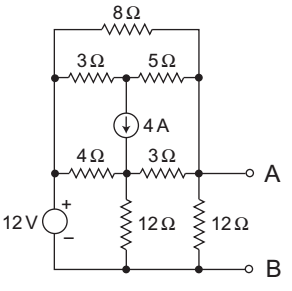
The equivalent circuit for calculation of Rth is shown below—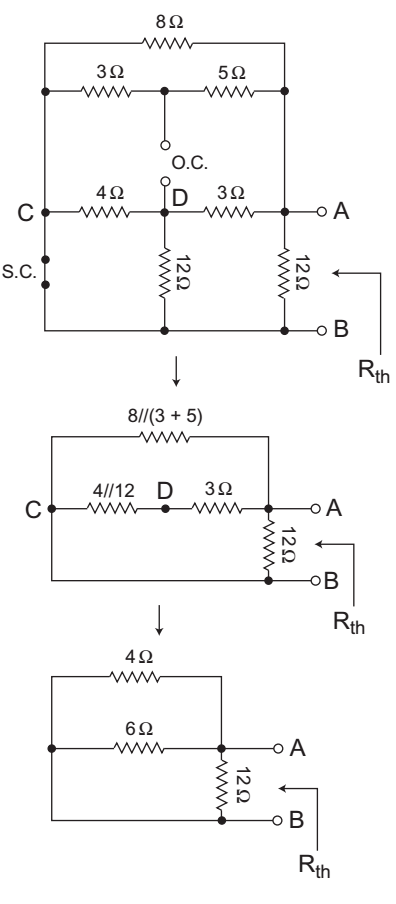
Now, from above figure1 = 1 + 1 + 1 Rth 4 6 12
or1 = 3 + 2 + 1 Rth 12
orRth = 12 = 2Ω 6
Hence alternative (A) is the correct choice.Correct Option: A
The given circuit:

The equivalent circuit for calculation of Rth is shown below—
Now, from above figure1 = 1 + 1 + 1 Rth 4 6 12
or1 = 3 + 2 + 1 Rth 12
orRth = 12 = 2Ω 6
Hence alternative (A) is the correct choice.
- The circuit shown in the above figure
1. is reciprocal
2. has Z11 = 2, Z22 = 2
3. has Z11 = 4, Z22 = 2
4. has Z11 = 0, Z22 = 2
Select the correct answer using the code given below—
-
View Hint View Answer Discuss in Forum
The given circuit:

Applying KVL in the input side, we get
V1 = 2I1 + I1.1 + (I1 + I2).1
or
V1 = 4I1 + I2 …. . . .(i)
Again applying KVL in the output side, we get
V2 = I2.1 + (I1 + I2).1
or
V2 = I1 + 2I2. . . . …(ii)
From equation (i) and (ii):
Z11 = 4Ω, Z12 = 1Ω
Z21 = 1Ω, Z22 = 2Ω
For the network to be reciprocal
Z12 = Z21 (Here Z11 = Z12 = 1Ω)
So, network is reciprocal
and
Z11 = 4Ω, Z22 = 2Ω
Therefore, statements 1 and 3 are correct.
Hence alternative (A) is the correct choice.Correct Option: A
The given circuit:

Applying KVL in the input side, we get
V1 = 2I1 + I1.1 + (I1 + I2).1
or
V1 = 4I1 + I2 …. . . .(i)
Again applying KVL in the output side, we get
V2 = I2.1 + (I1 + I2).1
or
V2 = I1 + 2I2. . . . …(ii)
From equation (i) and (ii):
Z11 = 4Ω, Z12 = 1Ω
Z21 = 1Ω, Z22 = 2Ω
For the network to be reciprocal
Z12 = Z21 (Here Z11 = Z12 = 1Ω)
So, network is reciprocal
and
Z11 = 4Ω, Z22 = 2Ω
Therefore, statements 1 and 3 are correct.
Hence alternative (A) is the correct choice.

